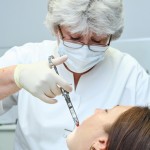
The management of pain during root canal treatment is important to patient and dentist. Failure to achieve anaesthesia during inferior alveolar nerve block ranges from 30-90% and is attributable to anatomical considerations, anxiety and or inflammation. Consequently, use of different types of anaesthetic agent, increasing solution volume and alternative injection techniques have been advocated with reviews suggesting better performance from mepivacaine and articaine and recommending further studies.
The aim of this study was to assess inferior alveolar nerve block (IANB) success of 2% mepivacaine and 4% articaine in patients with symptomatic irreversible pulpitis (SIP) in mandibular molars during access cavity preparation and instrumentation.
Methods
Systemically health patients aged 18-50 with moderate-to-severe pain in mandibular molars with SIP were randomised to receive either 3.6 ml 2% mepivacaine hydrochloride with 1:100 000 adrenalin or 3.4 ml 4% articaine hydrochloride with 1:100 000 adrenalin. Block randomisation was used with patients being treated by 5 operators using the same protocol. Patient assessed pain intensity (Intraoperative pain, IOP) was measured during access cavity preparation and canal instrumentation using 11-point Numerical Rating Scale (NRS). Overall anaesthetic success was considered when both coronal access preparation and instrumentation were performed without the need for supplemental anaesthesia. The need for supplemental anaesthesia was recorded. Outcome variables included IOP during access, IOP during instrumentation and the incidence of need for supplemental anaesthesia [Yes/No] Relative risk (RR) and 95% confidence interval (CI) of anaesthetic failure was also calculated
Results
- 330 patients (232 female,98 male), 203 first permanent molars, 123 second molars and 4 third molars were included.
- 5% reported severe preoperative pain, 18.5% moderate pain.
- No significant differences were seen between the two groups for pain incidence or intensity (see table below).
| Mepivacaine
(n = 165) |
Articaine
(n = 165) |
|
| Pain intensity – access | 4.41 (3.04) Mean (SD) | 3.95 (3.04) Mean (SD) |
| Pain intensity -instrumentation | 4.44 (3.06) Mean (SD) | 4.15 (2.96) Mean (SD) |
| Pain during access | ||
| No | 17.0% | 18.8% |
| Mild | 24.2% | 28.5% |
| Moderate | 32.1% | 29.1% |
| Severe | 26.7% | 23.6% |
| Pain during instrumentation | ||
| No | 17.6% | 17.0% |
| Mild | 21.2% | 26.7% |
| Moderate | 34.5% | 32.1% |
| Severe | 26.7% | 24.2% |
- Relative risk (RR) of anaesthetic failure for mepivacaine relative to articaine during
- Access preparation RR = 11 (95%CI; 0.92 to 1.35)
- Instrumentation RR = 09 (95%CI; 0.91 to 1.30)
- Overall risk of failure RR = 09 (95%CI; 0.91 to 1.30)
- Overall anaesthetic success rate was 35.8% for mepivacaine and 41.2% for articaine with the number failures shown in the table below.
| Mepivacaine | Articaine | |
| Access Preparation | 97(91.5%%) | 87(89.7%) |
| Instrumentation | 9(8.5%%) | 9(10.3%) |
| Total | 106 | 97 |
- 6% of the mepivacaine cases and in 38.2% % of the articaine cases required supplemental anaesthesia
- No adverse effects were reported.
Conclusions
The authors concluded: –
2% mepivacaine and 4% articaine demonstrate similar IANB success rates for mandibular molars with SIP. Intraoperative pain experience during endodontic treatment can be associated with preoperative pain, molar type and age.
Comments
This trial is registered on the ClinicalTrials.gov and follows the Preferred Reporting Items for RAndomised Trials in Endodontics (PRIRATE) 2020 guidelines (Nagendrababu, et al., 2020). It was undertaken in a single university setting and powered to detect a 15% difference in failure rate between the two groups. The use of 3.6 ml of 2% mepivacaine hydrochloride with 1:100000 adrenalin was compared with 3.4 ml of 4% articaine hydrochloride with 1:100000 adrenalin with no statistically significant differences seen between the two anaesthetic solutions. There were also no adverse effects such as paraesthesia, oedema, haematoma, dizziness, nausea, tremors, allergy or syncope. As the authors note while the two anaesthetic agents had similar efficacy, they have different chemical and pharmacokinetics which may affect clinical decision making. This was a large well conducted trial adds to the body of evidence from studies and systematic reviews.
Links
Primary Paper
Habib MFOM, Tarek S, Teama SME, Ezzat K, El Boghdadi RM, Marzouk A, Fouda MY, Gawdat SI, Bedier MM, Amin SAW. Inferior alveolar nerve block success of 2% mepivacaine versus 4% articaine in patients with symptomatic irreversible pulpitis in mandibular molars: A randomized double-blind single-centre clinical trial. Int Endod J. 2022 Nov;55(11):1177-1189. doi: 10.1111/iej.13810. Epub 2022 Aug 20. PMID: 35947082.
Clinical trials.Gov identifier NCT04822415
Other references
Nagendrababu V, Duncan HF, Bjørndal L, Kvist T, Priya E, Jayaraman J, Pulikkotil SJ, Dummer PMH. PRIRATE 2020 guidelines for reporting randomized trials in Endodontics: explanation and elaboration. Int Endod J. 2020 Jun;53(6):774-803. doi: 10.1111/iej.13304. Epub 2020 May 9. PMID: 32266988.
Dental Elf – 25th Feb 2022
Pulpal anaesthesia for symptomatic irreversible pulpitis in mandibular molars
Dental Elf – 27th Aug 2021
Dental Elf – 24th Jan 2022
https://www.nationalelfservice.net/dentistry/endodontics/anaesthetic-techniques-mandibular-posterior-teeth/,
